API requests
←APIs · Index↑ · Data type marshalling→
The endpoints are documented in the Configuration API.
Control session
Concurrency control is left to specific device implementations, however devices MUST always return relevant error response messages and statuses when there are conflicts, errors or other noteworthy states.
URL and usage
The ‘control’ endpoint URL provided in the IS-04 device MUST be used as the base URL for all subsequent requests.
As described in the Configuration API, the rolePaths endpoint MUST return all the device model’s role paths. Each rolePath MUST be created by appending NcObject roles starting with the root block and using . as the delimiter. Consequently the . character MUST not be used inside individual object roles.
It is RECOMMENDED for device model objects roles to use Unreserved Characters as described in RFC 3986 - 2.3. Unreserved Characters. When Reserved Characters are used in an object role, they MUST be URL encoded when included in the rolePaths endpoint and subsequently in a URL.
Device model object roles are case sensitive and thus any rolePaths and URLs which include them are also case sensitive as described in RFC 7230.
Property identifiers used as part of a URL MUST be represented as a string of the format {propertyLevel}p{propertyIndex} where:
- propertyLevel - number representing the inheritance level of the class containing the property (see Control Classes)
- propertyIndex - number representing the index level of the property within the specified inheritance level (see Control Classes)
Method identifiers used as part of a URL MUST be represented as a string of the format {methodLevel}m{methodIndex} where:
- methodLevel - number representing the inheritance level of the class containing the method (see Control Classes)
- methodIndex - number representing the index level of the method within the specified inheritance level (see Control Classes)
This means for a given base URL the root block can be targeted by using {baseUrl}/root as the URL. Furthermore, the userLabel of the root block can be targeted by using {baseUrl}/rolePaths/root/properties/1p6/value as the URL.
The following subsections define common use cases for the applicable HTTP verbs where resources are located using their associated rolePath.
| Verb | Scenario | URL format | Body | Response |
|---|---|---|---|---|
| GET | Get a property | baseUrl/rolePaths/{rolePath}/properties/{propertyId}/value | N/A | NcMethodResultPropertyValue with the contents of the property |
| GET | Get class descriptor | baseUrl/rolePaths/{rolePath}/descriptor | N/A | NcMethodResultClassDescriptor |
| GET | Get datatype descriptor | baseUrl/rolePaths/{rolePath}/properties/{propertyId}/descriptor | N/A | NcMethodResultDatatypeDescriptor |
| GET | Getting all the properties of a role path | baseUrl/rolePaths/{rolePath}/bulkProperties?recurse={value} | N/A | NcMethodResultBulkValuesHolder |
| PUT | Modify a property | baseUrl/rolePaths/{rolePath}/properties/{propertyId}/value | property-value-put-request | NcMethodResult |
| PUT | Setting bulk properties for a role path | baseUrl/rolePaths/{rolePath}/bulkProperties | bulkProperties-set-request | NcMethodResultObjectPropertiesSetValidation |
| PATCH | Invoke a method | baseUrl/rolePaths/{rolePath}/methods/{methodId} | method-patch-request | NcMethodResult |
| PATCH | Validating bulk properties for a role path | baseUrl/rolePaths/{rolePath}/bulkProperties | bulkProperties-validate-request | NcMethodResultObjectPropertiesSetValidation |
GET
Getting a property
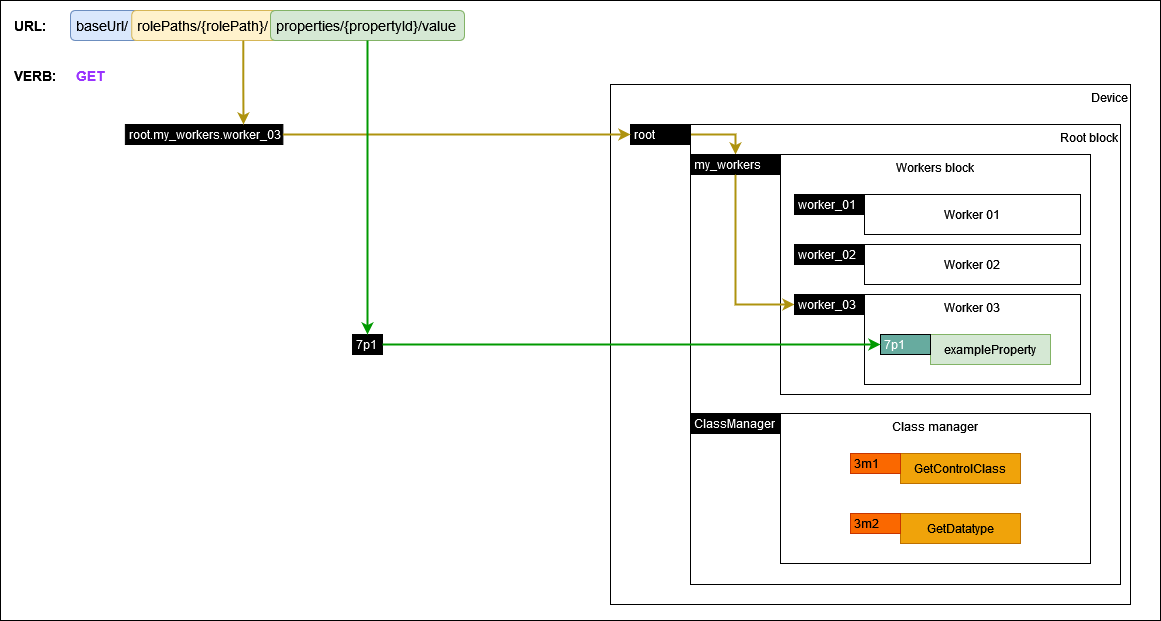 |
|---|
| Getting a property |
The URL MUST target a specific property of an object by locating the object using its role path and the property using its property identifier as per the following format baseUrl/rolePaths/{rolePath}/properties/{propertyId}/value. The response MUST be of type NcMethodResultPropertyValue containing the value of that property when successful. If the request encountered an error then the response result returned MUST be of type NcMethodResultError or a derived datatype and include an error message.
This is equivalent to invoking the generic Get method on the specific object for the required property.
Getting the class descriptor of an object
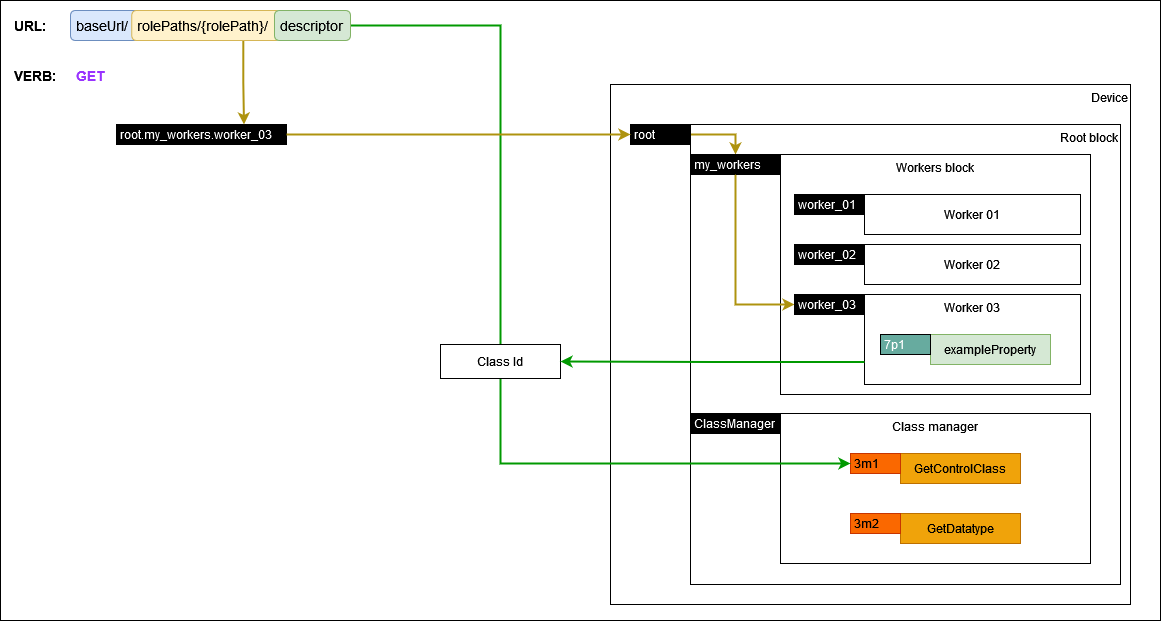 |
|---|
| Getting class descriptor |
The URL MUST target a specific object in the device model as per the following format baseUrl/rolePaths/{rolePath}/descriptor. A successful response MUST be of type NcMethodResultClassDescriptor including a descriptor which has all inherited elements. If the request encountered an error then the response result returned MUST be of type NcMethodResultError or a derived datatype and include an error message.
This is equivalent to invoking the GetControlClass method on the Class Manager object and including all inherited elements.
Getting the datatype descriptor of a property
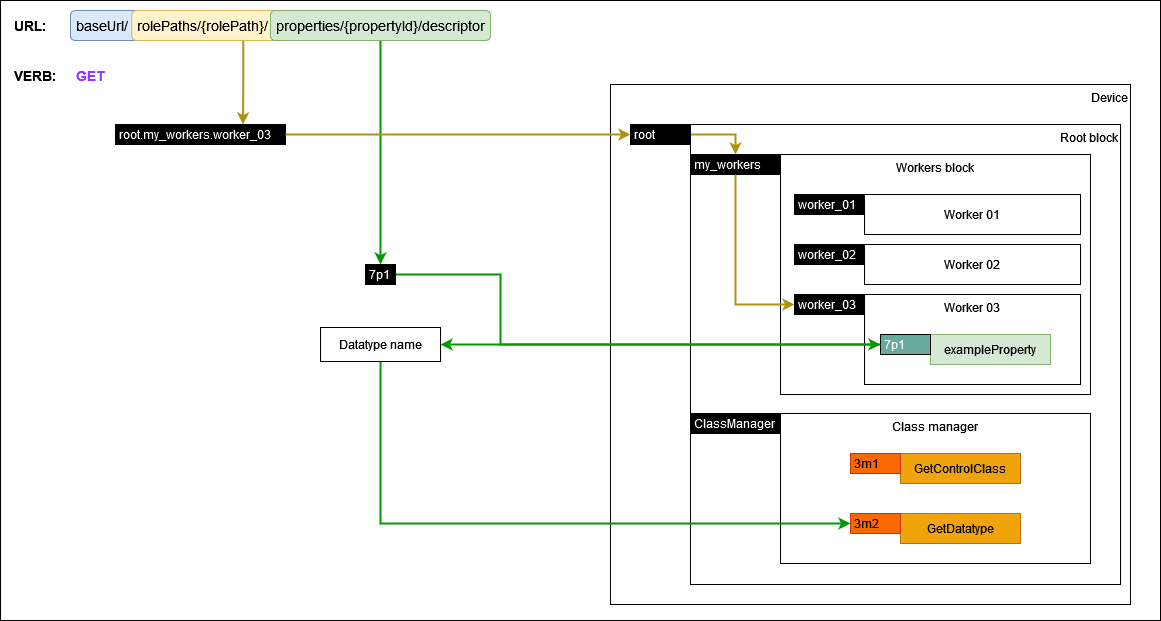 |
|---|
| Getting datatype descriptor |
The URL MUST target a specific property of an object by locating the object using its role path and the property using its property identifier as per the following format baseUrl/rolePaths/{rolePath}/properties/{propertyId}/descriptor. A successful response MUST be of type NcMethodResultDatatypeDescriptor including a descriptor which has all inherited elements. If the request encountered an error then the response result returned MUST be of type NcMethodResultError or a derived datatype and include an error message.
This is equivalent to invoking the GetDatatype method on the Class Manager object and including inherited elements.
Getting all the properties of a role path
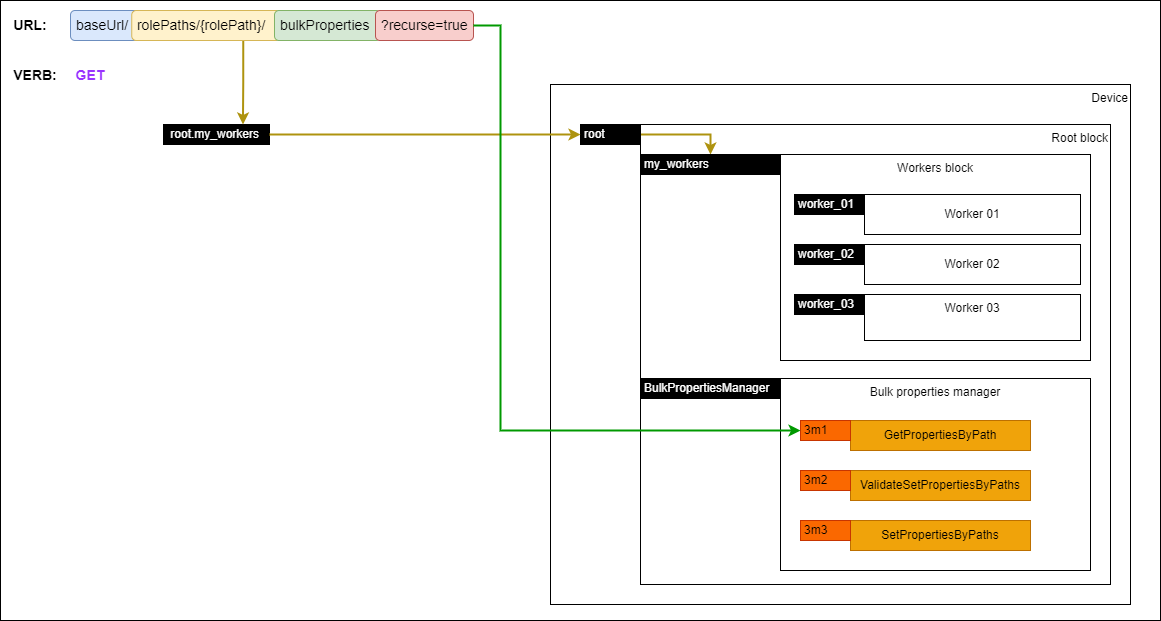 |
|---|
| Getting bulk properties |
The URL MUST target a specific role path in the device model by locating the object using its role path and optionally specifying the recurse parameter as per the following format baseUrl/rolePaths/{rolePath}/bulkProperties?recurse={true|false}. Not including the recurse query parameter MUST be treated as providing a recurse argument of true. A successful response MUST be of type NcMethodResultBulkValuesHolder and MUST include all the properties of the target role path as a bulk values holder. If the recurse argument is set to true then the response MUST include all the properties of the target role path as well as any nested role paths in a successful response. If the request encountered an error then the response result returned MUST be of type NcMethodResultError or a derived datatype and include an error message.
This is equivalent to invoking the GetPropertiesByPath method on the Bulk properties manager object.
Retrieving properties through the bulkProperties endpoint allows a user to perform a full backup or a partial backup.
A full backup is a backup data set returned by a GET operation on the /bulkProperties endpoint of the root block with the recurse parameter set to true.
A partial backup is a backup data set returned by a GET operation on the /bulkProperties endpoint of any object of the device model, other than the root block. A partial backup can also be obtained by a GET operation on the /bulkProperties endpoint of the root block with the recurse query parameter set to false; however this will only result in a backup of the root block only.
PUT
Changing a property
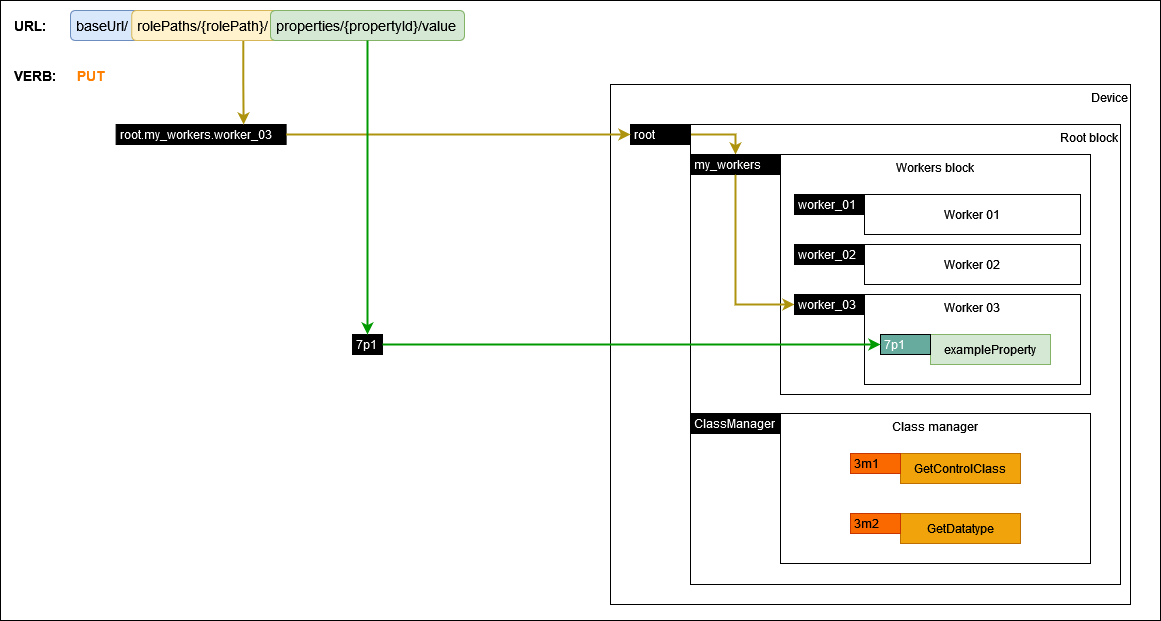 |
|---|
| Putting a property |
The PUT verb MUST be used for setting individual object properties.
The URL MUST target a specific property of an object by locating the object using its role path and the property using its property identifier as per the following format baseUrl/rolePaths/{rolePath}/properties/{propertyId}/value. A successful response MUST be of type NcMethodResult. If the request encountered an error then the response result returned MUST be of type NcMethodResultError or a derived datatype and include an error message.
The body of the request MUST include an object which includes the new value of the property as per the property-value-put-request schema.
This is equivalent to invoking the generic Set method on the specific object for the required property.
Setting bulk properties for a role path
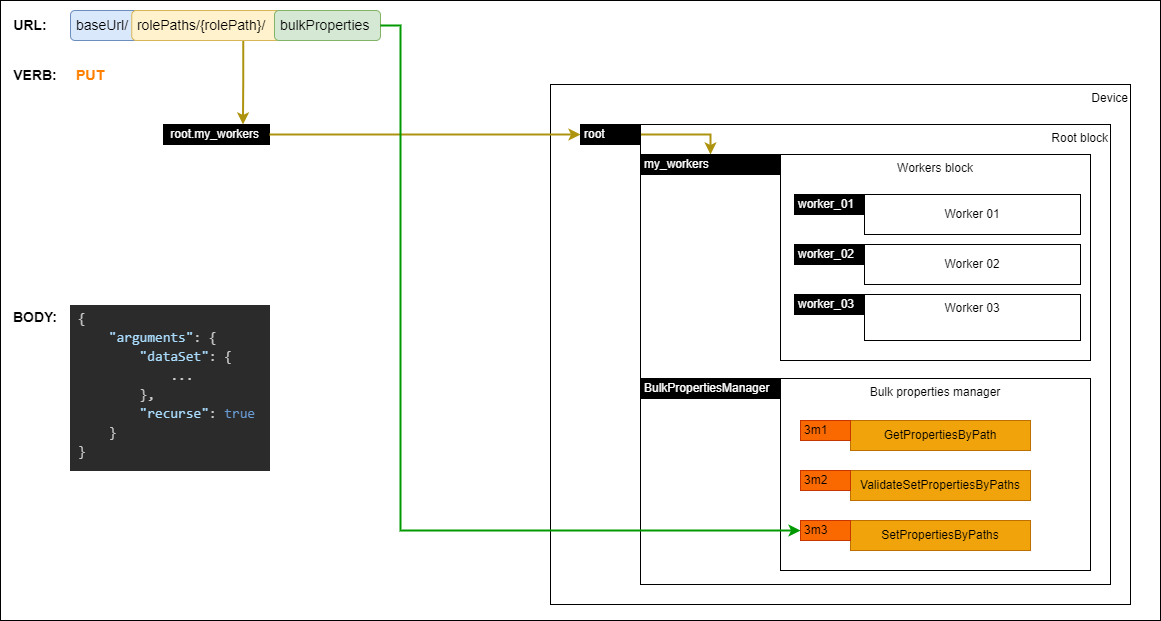 |
|---|
| Setting bulk properties |
The PUT verb MUST be used for setting a bulk properties data set.
The URL MUST target a specific object using its role path as per the following format baseUrl/rolePaths/{rolePath}/bulkProperties.
The body of the request MUST include an object which includes an arguments object with dataSet, recurse and restoreMode sub elements as per the bulkProperties-set-request schema.
{
"arguments": {
"dataSet": {
...
},
"recurse": true,
"restoreMode": 1
}
}
If the recurse value is true then the device MUST target the properties of the target role path and all nested role paths in its attempt to use the provided dataSet.
A successful response MUST be of type NcMethodResultObjectPropertiesSetValidation. If the request encountered an error then the response result returned MUST be of type NcMethodResultError or a derived datatype and include an error message.
This is equivalent to invoking the SetPropertiesByPath method inside the Bulk properties manager object.
Setting properties through the bulkProperties endpoint allows a user to perform a restore.
PATCH
Invoking a method
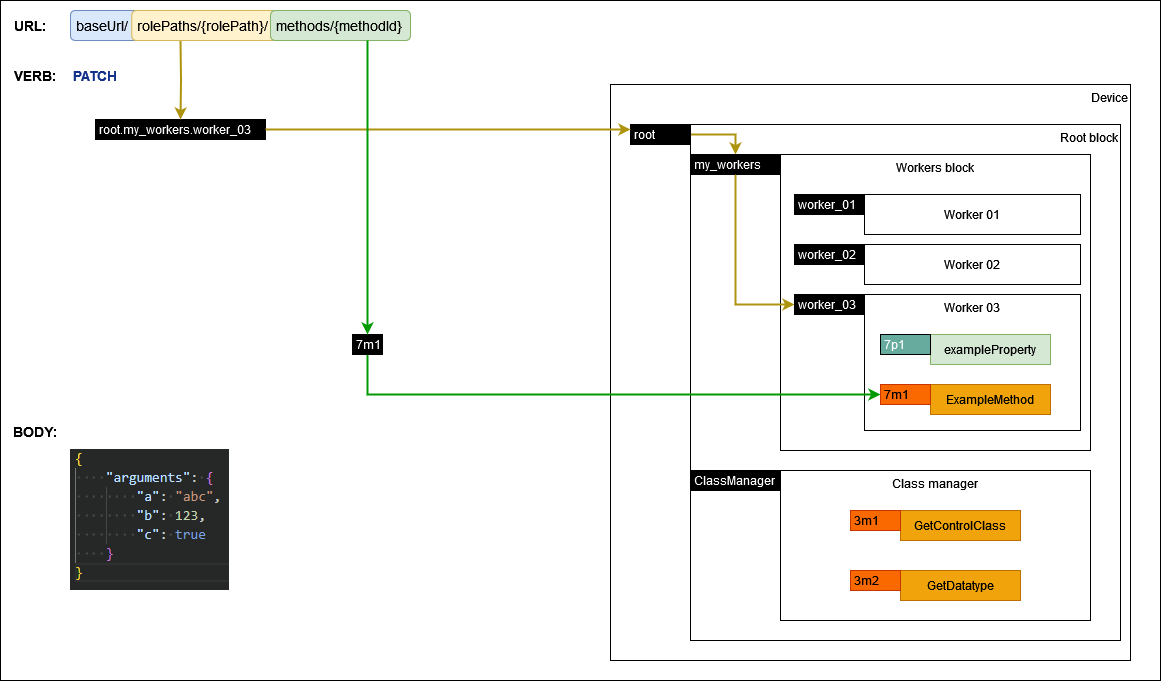 |
|---|
| Invoking a method |
The PATCH verb MUST be used for invoking object methods.
The URL MUST target a specific method of an object by locating the object using its role path and the method using its method identifier as per the following format baseUrl/rolePaths/{rolePath}/methods/{methodId}.
The body of the request MUST include an object which includes an arguments object as per the method-patch-request schema. For methods which do not have arguments defined the request body MUST include an empty arguments object.
{
"arguments": {
...
}
}
A successful response MUST be of type NcMethodResult. If the request encountered an error then the response MUST either be of the type, or inherited from the type, NcMethodResultError and include an error message.
This is equivalent to invoking the specified method.
Validating bulk properties for a role path
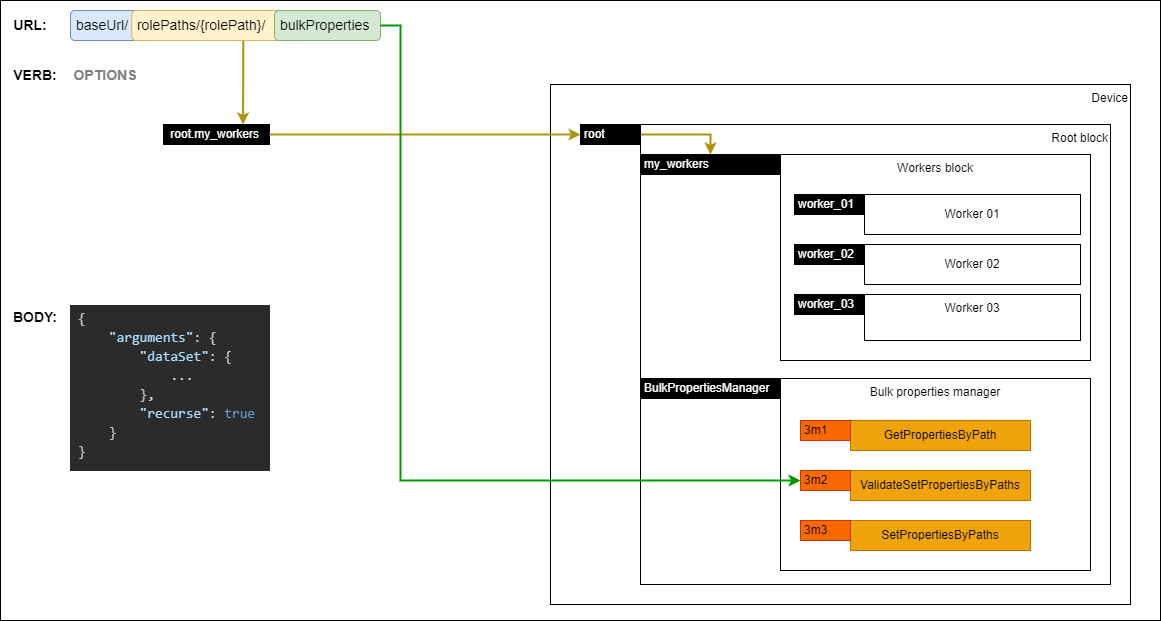 |
|---|
| Validating bulk properties |
The PATCH verb MUST be used for validating a bulk properties data set.
The URL MUST target a specific object using its role path as per the following format baseUrl/rolePaths/{rolePath}/bulkProperties.
The body of the request MUST include an object which includes an arguments object with dataSet, recurse and restoreMode sub elements as per the bulkProperties-validate-request schema.
{
"arguments": {
"dataSet": {
...
},
"recurse": true,
"restoreMode": 1
}
}
If the recurse value is true then the device MUST target the properties of the target role path and all nested role paths in its attempt to use the provided dataSet.
A successful response MUST be of type NcMethodResultObjectPropertiesSetValidation. If the request encountered an error then the response result returned MUST be of type NcMethodResultError or a derived datatype and include an error message.
An API call to validate bulk properties MUST NOT result in any changes to the device model.
This is equivalent to invoking the ValidateSetPropertiesByPath method inside the Bulk properties manager object.
This provides a validation mechanism for a client to use before attempting to perform a restore by applying bulk properties.

